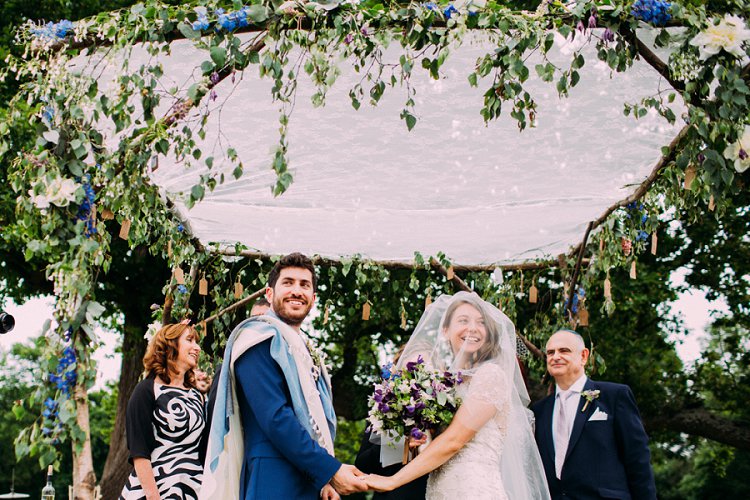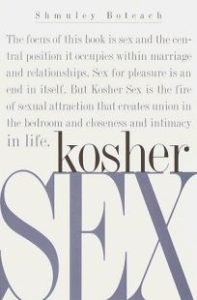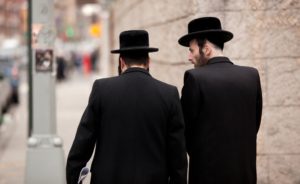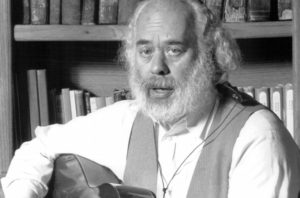Jews, Sex Positivity, and Abuse
Stories of Judaism’s sex positivity can get in the way of seeing abuse within Jewish communities.
 A common refrain in Jewish communities goes something like this: Unlike Christianity, with its talk of sin and sexual repression, Judaism is sex-positive.
A common refrain in Jewish communities goes something like this: Unlike Christianity, with its talk of sin and sexual repression, Judaism is sex-positive.
Judaism may not have celibate priests or associate sex with original sin the way some Christian denominations do, but the lack of these prohibitions has not created a sexual utopia. In fact, the assumption that Judaism frames sex positively has made it difficult to see when sexual abuse happens in Jewish contexts.
The sex-positive sentiment spans the spectrum of Jewish observance. In his book Kosher Sex: A Recipe for Passion and Intimacy, the celebrity Chabad rabbi Shmuley Boteach would have his readers believe that “unlike other religious traditions, Judaism has never had a prudish or conservative sexual ethic. On the contrary, Judaism has always celebrated the commitment that exists between a loving man and woman.” Likewise, Maggie Anton, who grew up secular and became interested in the Talmud as an adult, writes gleefully in her Fifty Shades of Talmud, “I bet Judaism would attract a lot more converts if the commandment to have sex were better publicized.”
These proclamations come from one interpretation of the tradition, but in order to make this argument you must read certain passages selectively and ignore others entirely. Some Talmudic passages compare a man’s wife to purchased meat and suggest a husband can do whatever he likes sexually with his wife. Others imply that disabled children are the result of looking at a woman’s vagina, euphemized in the text as “that place.” Nevertheless, most practitioners of Judaism continue to see their religious tradition as supporting healthy sex—whether they see healthy sex as exclusively between a married man and woman or any monogamous couple, regardless of gender.
 Religious Jews also find contemporary values like consent in Jewish texts. Recently a Jewish sex educator wrote in the popular online Jewish magazine Tablet: “What I learned was that the Talmudists, a cisgender male group of rabbis who sat around and discussed Torah in all its nooks and crannies, predicted the same problems of sexual violence and coercion in the fifth century that consume our culture in 2018. They gave the tools a long time ago, embedded in the Jewish textual canon, to establish a sexual culture of consent.” Likewise, Maggie Anton celebrated the Talmud’s authors as (mostly) good guides for sexual ethics today: “Considering how long ago the Talmud promulgated these ideas, it is remarkable that most people today would agree that the very practices … the Rabbis condemned are truly reprehensible.”
Religious Jews also find contemporary values like consent in Jewish texts. Recently a Jewish sex educator wrote in the popular online Jewish magazine Tablet: “What I learned was that the Talmudists, a cisgender male group of rabbis who sat around and discussed Torah in all its nooks and crannies, predicted the same problems of sexual violence and coercion in the fifth century that consume our culture in 2018. They gave the tools a long time ago, embedded in the Jewish textual canon, to establish a sexual culture of consent.” Likewise, Maggie Anton celebrated the Talmud’s authors as (mostly) good guides for sexual ethics today: “Considering how long ago the Talmud promulgated these ideas, it is remarkable that most people today would agree that the very practices … the Rabbis condemned are truly reprehensible.”
Why should these stories matter if we’re talking about sexual abuse? One reason is the prominent assumption that sexual abuse is about bad sexuality, and that bad sexuality is a product of the norms and laws with which a person is raised. Too often this line of reasoning says: Maybe bad sexuality and abuse are because of repression, restriction, or prohibition. If only we had the right rules, then we would have good sexuality and less abuse. Bad rules create bad sexuality and, in turn, sexual misconduct and violence. Ideas like this are behind interpretations of the abuse crisis in the Roman Catholic Church that blame abuse on the mandatory celibacy of priests. Such assumptions circulate throughout the media and among scholars. An Australian report, for example, claimed that “mandatory celibacy and a culture of secrecy created by popes and bishops are major factors” in sexual abuse. Even an academic article claims that “mandatory celibacy” helps “create the problem.”
Judaism, in this view, should have spaces where sexual abuse is far less common than in other communities. It does not promote celibacy, it does not see sex as a necessary evil, and it does not attach shame to sexuality. The idea that repressive rules about sex make sexual abuse more commons is appealing because it implies that if we created a space with the right norms and laws—whether religious or secular—we could create a community that minimized sexual abuse. But however appealing these ideas are, they are misguided.
Perhaps it should go without saying, but Judaism and Jewish communities can also be places of sexual abuse. In fact, statistically, Jews across the spectrum of observance report numbers that are similar to other populations. Yet the stories of Judaism’s sex positivity can get in the way of seeing and understanding that abuse. In this way, it is similar to domestic violence, which went long unacknowledged in Jewish communities because of prominent ideas of Jewish families and homes as peaceful (an ideal known as shalom bayit), religious ideals of Jewish men as gentle and kind, and textually-based stereotypes about non-Jews as unrestrained, particularly in matters of drinking, violence, and sex. Because the Jewish tradition told a story about domestic abuse as though it were not a problem for Jews, it was easier for Jewish communities to overlook it or assume it was an anomaly when it happened. Because of these stories and the religious values they impart, it can be difficult for Jewish communities to see sexual abuse.
Although the statistics about sexual abuse are similar within and outside of Jewish communities, this does not mean that Judaism bears no responsibility for the sexual abuse that happens in Jewish spaces. Two examples, both painfully relevant for today as well as stretching back many years, demonstrate why looking at Judaism matters when thinking about religion and sexual abuse.
***
Haredi communities, often called “ultraorthodox,” have struggled with how to deal with sexual assault for years. These communities, mostly based in New York and Israel, see themselves as rejecting the secular world around them in many ways: they eschew secular media including much of the internet, they adhere to strict gender-based dress codes and norms of behavior, and they have few mixed-gender spaces outside of the home. They see non-Jewish (and non-observant Jewish) cultures as both inferior and threatening to their way of life.
Because of gender segregation in Haredi communities, when sexual abuse happens it tends to occur either in the home or in single-gender spaces. When Haredi boys or young men have come forward telling of sexual abuse, the communal leaders—mostly rabbis—have often doubted their accounts. Worse, some leaders have asked the victims to keep quiet or have blamed them for seducing the men who abused them. In the vast majority of cases, communal leaders have told victims they must deal with the issue entirely within the community and not involve law enforcement or secular courts.
 The move to insularity is not distinctly Jewish, but in this case Jewishness matters. These Haredi Jews are a minority community—in fact, a minority within a minority—and they are concerned about antisemitism. Involving outsiders in such private and terrible matters could incite others to turn against them. Because of a history of persecution, Haredim also have what amounts to a “no snitching” practice; they prohibit mesirah, a Jew turning over another Jew to non-Jewish authorities, at least under most circumstances. This has become a matter of significant friction: should Haredi Jews turn over adults who sexually abuse children to secular authorities? And if so, when?
The move to insularity is not distinctly Jewish, but in this case Jewishness matters. These Haredi Jews are a minority community—in fact, a minority within a minority—and they are concerned about antisemitism. Involving outsiders in such private and terrible matters could incite others to turn against them. Because of a history of persecution, Haredim also have what amounts to a “no snitching” practice; they prohibit mesirah, a Jew turning over another Jew to non-Jewish authorities, at least under most circumstances. This has become a matter of significant friction: should Haredi Jews turn over adults who sexually abuse children to secular authorities? And if so, when?
Agudath Israel, the largest leadership and policy organization representing Haredi Jews, recently declared that a member of the community who experienced abuse should first go to a rabbi within the community, and only then would that rabbi make the decision about what to do next: “The individual should not rely exclusively on his own judgment to determine” whether to go to the authorities. “Rather, he should present the facts of the case to a rabbi who is an expert in halacha [Jewish law] and who also has experience in the area of abuse and molestation” because the rabbi understands “the gravity of halacha.” Others worry that this approach will continue to silence victims. They advocate, instead, calling the police whenever someone reports abuse. Although the possibility of calling the police, or even a highly contested hotline run by a Haredi man, has grown in recent years, the default is still to keep reports of sexual abuse exclusively within the community.
The disagreement is fundamentally about the boundaries between the religious community and those outside it—who should have the power to punish and shame, and, more fundamentally, whether the misdeeds of one person should be handled within the community or submitted to an authority beyond it.
***
Sexual abuse, of course, is not just the provenance of the ultraorthodox. Perhaps the most widely known case of inappropriate sexual behavior, including sexual abuse, involves the countercultural rabbi Shlomo Carlebach. Although Carlebach died in 1994, many Jewish communities are still coming to terms with his actions (unwanted sexual touching, inappropriate late-night phone calls, and worse) as well as the testimonies of the women he harmed . However, countless synagogues across the United States still use his melodies as part of their services, and so his presence continues.

Rabbi Shlomo Carlebach
Judaism should be a religion of love, Carlebach preached. His synagogue’s name—The House of Love and Prayer—declared that same message for how Jews across the religious spectrum should see Judaism. Part of Carlebach’s appeal as a religious leader was his charisma, and part of the appeal of his movement was a utopian vision of intimate connections with God and other people. These aspects of his appeal also helped him push the idea that Judaism should not have sexual regulation at the forefront of its religious ideology. The strict rules around menstruation in Jewish law and the practices prohibiting touching between men and women didn’t fit with the lives of most of Carlebach’s followers, nor did they seem to matter to his conception of Judaism. Carlebach sought to break down boundaries between people, rather than to build them up. But that very worldview also facilitated abuse. It also made it difficult for others to hear or believe the women who experienced abuse because of how deeply people loved Carlebach and the community he created.
***
In many ways, these two examples could not be more different: an ultraorthodox community and a more liberal one; an insular community that seeks to keep all stories of abuse under wraps, and women who bravely went public with their stories of abuse at the hands of an internationally beloved rabbi; one about the boundaries between a religious community and the society around it, and the other about the interpersonal and social boundaries of sex and sexuality.
Yet the abuse in both Haredi communities and Carlebach’s community were facilitated by the stories that Jews told themselves about Judaism. One story says, “Our Judaism is traditional and moral when it comes to sexuality.” The other says, “Our Judaism is enlightened and progressive about intimacy and sexuality.” Both of these stories get in the way of recognizing sexual abuse as a systemic problem — and a Jewish one.
Sarah Imhoff is Associate Professor in the Department of Religious Studies and the Borns Jewish Studies Program at Indiana University. She writes about religion and the body with a particular interest in gender, sexuality, race, and American religion. She is the author of Masculinity and the Making of American Judaism (Indiana University Press, 2017). Her current projects include A Queer Crippled Zionism: The Lives of Jessie Sampter and an exploration of gender-based inclusions and exclusions in Jewish Studies, co-authored with Susannah Heschel.
***
Published with support from the Henry R. Luce Initiative on Religion in International Affairs.